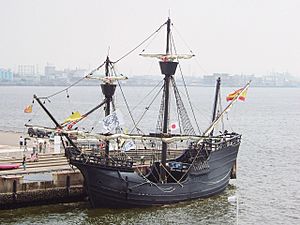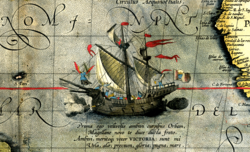Victoria (ship) facts for kids

|
|
Quick facts for kids History |
|
|---|---|
| Crown of Spain | |
| Name | Victoria |
| Namesake | Santa Maria de la Victoria |
| Owner | Crown of Spain |
| Acquired | 1518 |
| Renamed | 1519 |
| Fate | Disappeared en route to Seville from the Antilles, 1570 |
| Notes | First ship to circumnavigate the globe. |
| General characteristics | |
| Class and type | Carrack |
| Tonnage | 85 tonels |
| Length | 18 to 21 m (59 to 69 ft) |
| Complement | 55 |
The Victoria or Nao Victoria (which means "Victory" in Spanish) was a famous carrack. A carrack was a large sailing ship used for trade and exploration. The Victoria became the first ship to successfully sail all the way around the world.
This amazing journey was part of a Spanish trip led by explorer Ferdinand Magellan. The goal was to reach the Moluccas (now called the Maluku Islands in Indonesia). The expedition started from Seville, Spain, on August 10, 1519, with five ships. They entered the ocean from Sanlúcar de Barrameda on September 20.
Magellan died in the Philippines in 1521 during a battle. Only two ships reached the Moluccas. After that, the Victoria was the only ship to complete the return trip. It sailed across unknown parts of the Indian Ocean. Juan Sebastián Elcano took command of the ship. The Victoria returned to Sanlúcar on September 6, 1522, completing its journey around the world.
The Victoria was built in a Basque shipyard in Ondarroa. King Charles I of Spain gave the Victoria and four other ships to Magellan. The Victoria was an 85-tonel ship. It started with a crew of about 42 people.
Magellan's own ship was the Trinidad. It was a carrack of 100 or 110 tonels with about 55 men. The other ships were the carrack San Antonio (120 tonels, 60 men), the carrack Concepción (90 tonels, 45 men), and the caravel Santiago (75 tonels, 32 men).
Many challenges faced the expedition:
- The Santiago was lost off the coast of Argentina.
- The San Antonio left the trip and went back to Spain after a failed mutiny (a rebellion by the crew).
- The Concepción was sunk after a conflict in the Philippines.
- The Trinidad was captured by the Portuguese and later lost in a storm.
Contents
The Ship's Name
The Victoria was named after a convent in Seville. This convent was called Our Lady of Victory of Triana. Magellan made his promise of loyalty to King Charles I at this convent. The convent was later taken apart during the Napoleonic Wars.
How the Ship Was Built
People used to think the Victoria was built in Zarautz. This town is near Getaria, where Elcano was from. But new studies show the Victoria was built in the shipyards of Ondarroa in Biscay.
The ship was first called Santa Maria. It belonged to a ship pilot named Domingo Apallua and his son. In 1518, the ship was used for trading between Castile (part of Spain) and England. Spanish officials bought the ship for 800 gold ducats. Magellan renamed the ship Victoria after the chapel where he often prayed in Seville.
The Crew's Journey
The voyage began with about 265 men on five ships. But only 18 men returned alive on the Victoria. Many others left the expedition or died. A lot of men died from not having enough food.
At the start of the trip, Luis de Mendoza was the captain of the Victoria. In April 1520, a mutiny happened in Puerto San Julian in Patagonia. Three captains were involved, but the rebellion was stopped. Luis de Mendoza and Gaspar Quesada, captain of the Concepción, were killed.
Juan de Cartagena, captain of the San Antonio, was left alone on the coast. After Magellan died in April 1521, the remaining crew tried to get his body but could not. Duarte Barbosa and João Serrão became the new leaders. In May 1521, they were invited to a feast by Rajah Humabon of Cebu. Most of the crew were killed or poisoned at this feast.
Pilot João Carvalho survived the trap and became the captain of the Victoria. In August, near Borneo, he was replaced. Juan Sebastián Elcano then became captain for the rest of the journey.
Returning Crew Members
Out of the original 260 people, only 18 returned to Seville with the Victoria. This was because of a lack of food and a serious disease called scurvy. Other crew members had sailed back with the Santiago, which left the expedition. Some others returned later after being captured by the Portuguese.
Here are some of the brave people who returned:
| Name | Role | Nationality | Hometown |
|---|---|---|---|
| Juan Sebastián Elcano | Master | Basque | Getaria |
| Francisco Albo | Pilot | Greek | Chios |
| Miguel de Rodas | Pilot | Gallician | Tui |
| Juan de Acurio | Pilot | Basque | Bermeo |
| Antonio Lombardo (Pigafetta) | Extra Crew Member | Venetian | Vicenza |
| Martín de Judicibus | Chief Steward | Genoese | Genoa |
| Hernándo de Bustamante | Mariner | Castillian | Alcántara |
| Nicholas the Greek | Mariner | Greek | Nafplion |
| Miguel Sánchez | Mariner | Basque | Tui |
| Antonio Hernández Colmenero | Mariner | Basque | Ayamonte |
| Francisco Rodrigues | Mariner | Portuguese | Seville |
| Juan Rodríguez | Mariner | Castillian | Huelva |
| Diego Carmena | Mariner | Gallician | Baiona |
| Hans of Aachen | Gunner | German | Aachen |
| Juan de Arratia | Able Seaman | Basque | Bilbao |
| Vasco Gómez Gallego | Able Seaman | Gallician | Baiona |
| Juan de Santandrés | Apprentice Seaman | Castillian | Cueto |
| Juan de Zubileta | Page | Basque | Barakaldo |
Three of these survivors wrote about their experiences. Elcano wrote a letter to the Emperor. Francisco Albo kept a logbook with the ship's location each day. Antonio Pigafetta wrote a detailed story of the journey.
The Amazing Voyage
The long trip around the world started in Seville in 1519. The Victoria returned to Sanlúcar de Barrameda on September 6, 1522. The ship had sailed about 68,000 kilometres (42,000 mi). About 35,000 kilometres (22,000 mi) of this distance was in areas unknown to the crew.
On December 21, 1521, the Victoria sailed alone from Tidore in Indonesia. The other ships had left because they ran out of food. The Victoria was in very bad shape. Its sails were torn, and it stayed afloat only by constant pumping of water.
Despite the difficulties, the Victoria made it back to Spain. It carried a large amount of spices. The value of these spices was more than the cost of the entire original fleet!
The Victoria was later fixed up. A merchant bought it, and it sailed for almost 50 more years. Sadly, it was lost with all its crew on a trip from the Antilles to Seville around 1570.
Legacy of the Victoria
The Victoria was shown on many maps from the 1500s. These included the Salviati Planisphere and Abraham Orterlius's map of the Pacific Ocean.
A small picture of the Victoria is the logo of the Hakluyt Society. This group in London publishes old records of historic voyages and travels. The logo is on the cover of all their books.
Replicas of the Ship
A copy of the Victoria was built in 1992 for the Universal Exposition in Seville. This replica is now managed by the Fundación Nao Victoria.
To celebrate 500 years since the first trip around the world, the Fundación Nao Victoria ordered a second replica. This new copy was launched on February 11, 2020. It is now a permanent exhibit near the Torre del Oro in Seville.
In 2006, a project started in Punta Arenas, Chile, to build another replica. This was to celebrate the Bicentennial of Chile. Finding the original plans for the Victoria took a long time. The project was delayed from 2006 to 2009. The replica was finally finished in 2011. Even though it was not ready for the 2010 celebration, the project's creator received a special medal from the President of Chile.
Images for kids
-
2011 replica of Nao Victoria built in Punta Arenas, Chile
See also
 In Spanish: Victoria (nao) para niños
In Spanish: Victoria (nao) para niños




